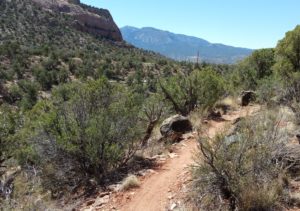I’ve set more than one story here at Sand Canyon. Sand Canyon is noted for its Ancestral Puebloan ruins. Some are so far back in the canyon, and so concealed in the upper alcoves, that you can walk right past without seeing them. That was their whole point: to hide.
The Anasazi, as they are sometimes called, were a culture in crisis by the time they moved to these inaccessible locations, often in the cliffs bordering wending canyons. Archaeologists now believe that this ancient Puebloan civilization, which had built small cities, road systems and extensive trading networks, were under pressure from drought and from each other. Yet, like the declines of other civilizations throughout history all over the planet, the reasons for the swift dismantling of the Anasazi from larger aggregations to smaller bands are multifactorial.
Sometimes, as I wander through these desiccated lands and peer in at the ghostly remains of their homes, I picture children playing, adults hauling in water, smoke rising from firepits on cold winter days. I see the tragedy of a culture fractured by lack of water, breaking up into smaller bands just to survive. I imagine farmers moving closer to rivers and streams as irrigation fails. I envision water sources drying up, agricultural animals dying. I see us.
Don’t let the tufts of snow atop Sleeping Ute Mountain (look real close) fool you. We haven’t had significant rain or snowfall since last October, and it’s mid-May, with temperatures in the 80’s and 90’s. Down in southern Arizona, they’re already in the triple digits. How different is our situation than it was for the Anasazi a few hundred years before?
How different are we than the people who built the civilization at Chaco Canyon? In some ways, we’re more vulnerable. There are millions of us using desert and semi-desert as if it were temperate land. We’re building golf courses, installing lawns and fountains, lighting up the desert at night with casino neon that blots the stars.
The cities take the water away from precious wildland and agricultural, voting themselves the rights. The West is filling in. Small towns like Durango, Colorado, 70 miles west of here, are exploding with development. Even Cortez, the seat of rural Montezuma County, is expanding beyond what anyone might’ve envisioned just a few years ago.
The earlier 20th century, upon which the projections for the dammed rivers and the hydropower they would produce were based, may have been an unusually wet period compared to baseline rates of precipitation. If the Ancestral Puebloans were unable to maintain their lifestyles, indeed, their lives, during the droughts of their era, how will we?
© 2022 by Michael C. Just
Mike’s novel, The Dirt: The Journey of a Mystic Cowboy, is available in softcover or eBook formats through Amazon.
You can purchase the book through this website. Or go straight to amazon at https://www.amazon.com/s?k=the+dirt+journey+of+a+mystic+cowboy&crid=1S40Q4BXSUWJ6&sprefix=the+dirt%3A+journey+of+a+m%2Caps%2C180&ref=nb_sb_ss_i_1_23
Mike’s other titles, including The Crippy, The Mind Altar, and Canyon Calls, are available through this website or through Amazon at https://www.amazon.com/-/e/B002
Four of his short stories have recently been published online:
Lies, Ltd. has been published by The Mystery Tribune @ Lies, Ltd.: Literary Short Fiction by Michael C. Just (mysterytribune.com)
The Obligate Carnivore has been published by the Scarlet Leaf Review @ Category: MICHAEL JUST – SCARLET LEAF REVIEW
I See You, Too has been published by the 96th of October @ I See You, Too – 96th of October
Offload, a short story about a man who can heal any disease, is now live and can be read at The Worlds Within at Offload – The Worlds Within


